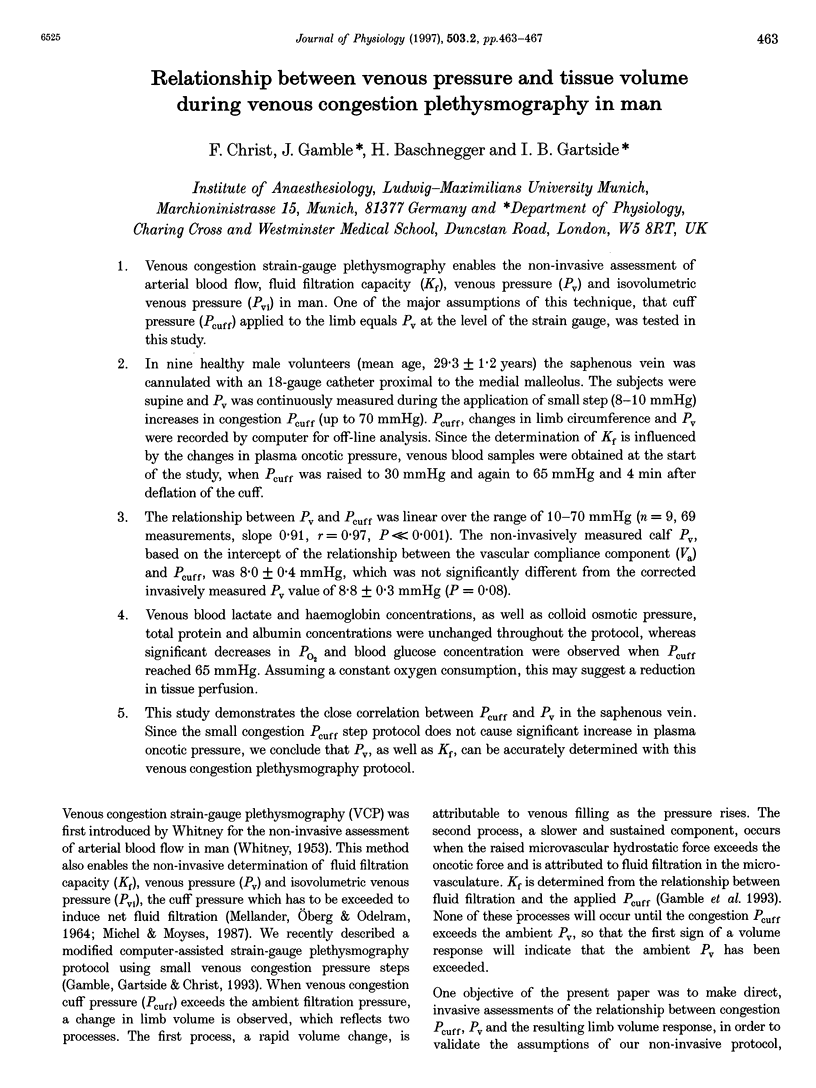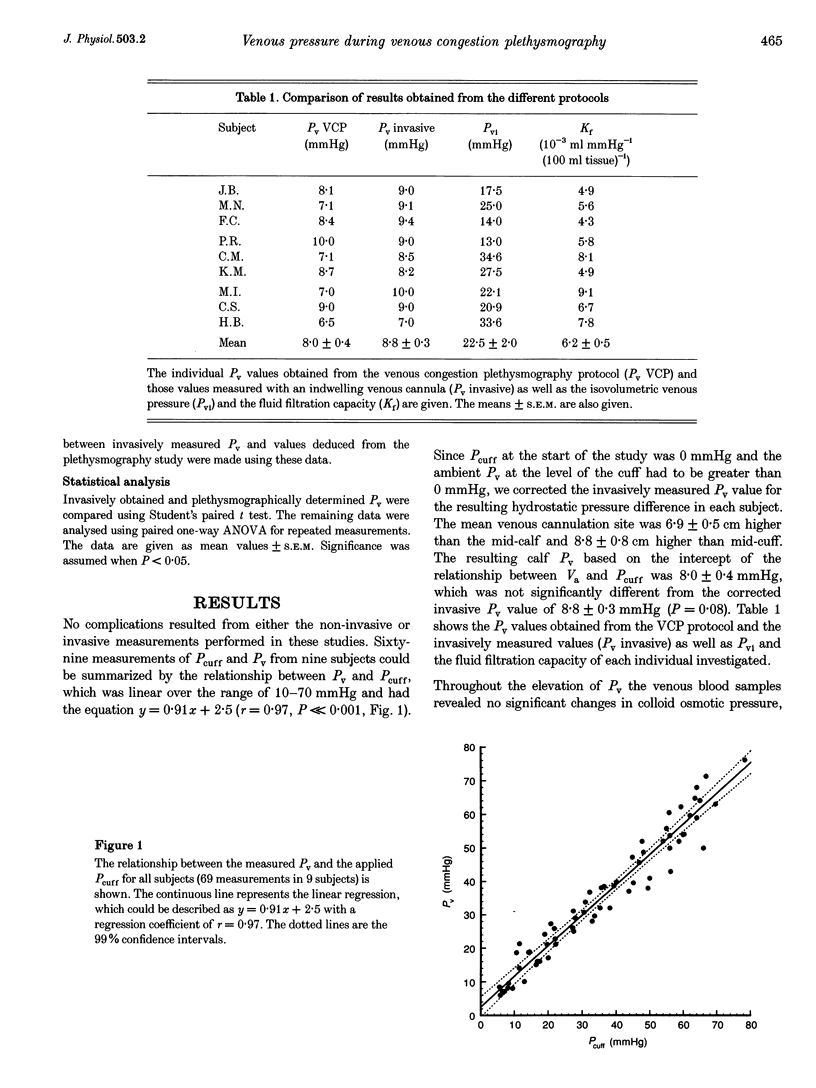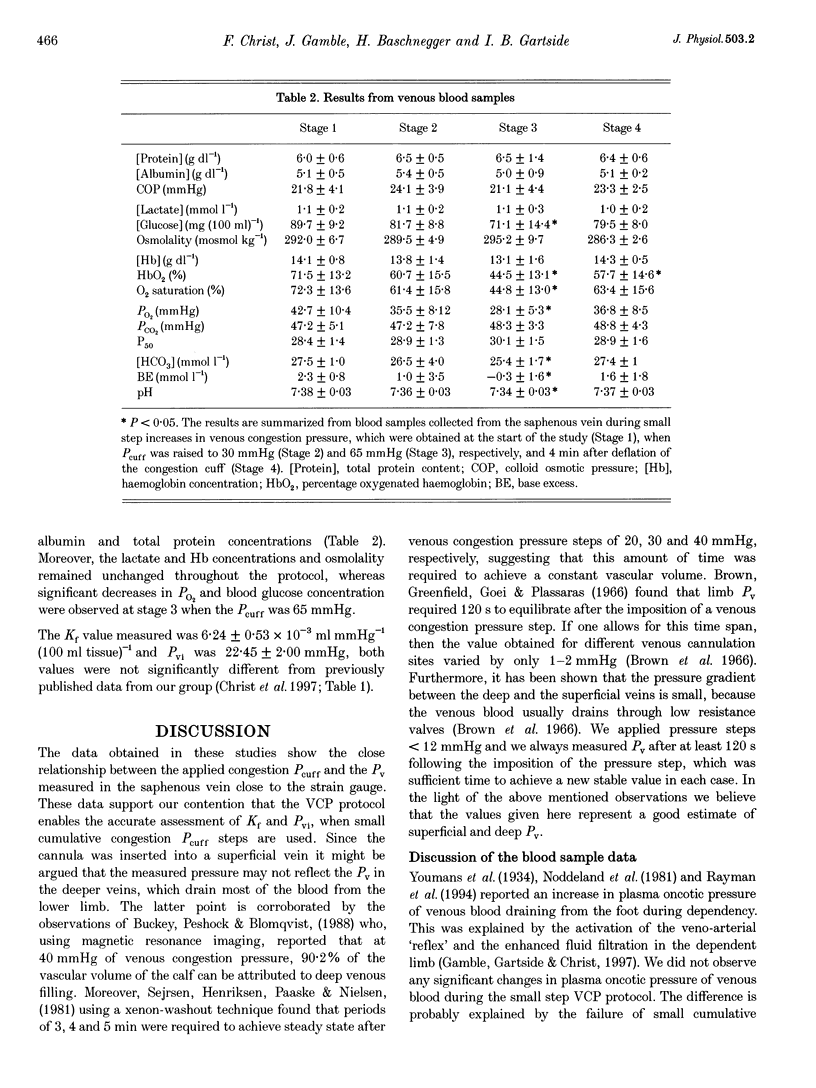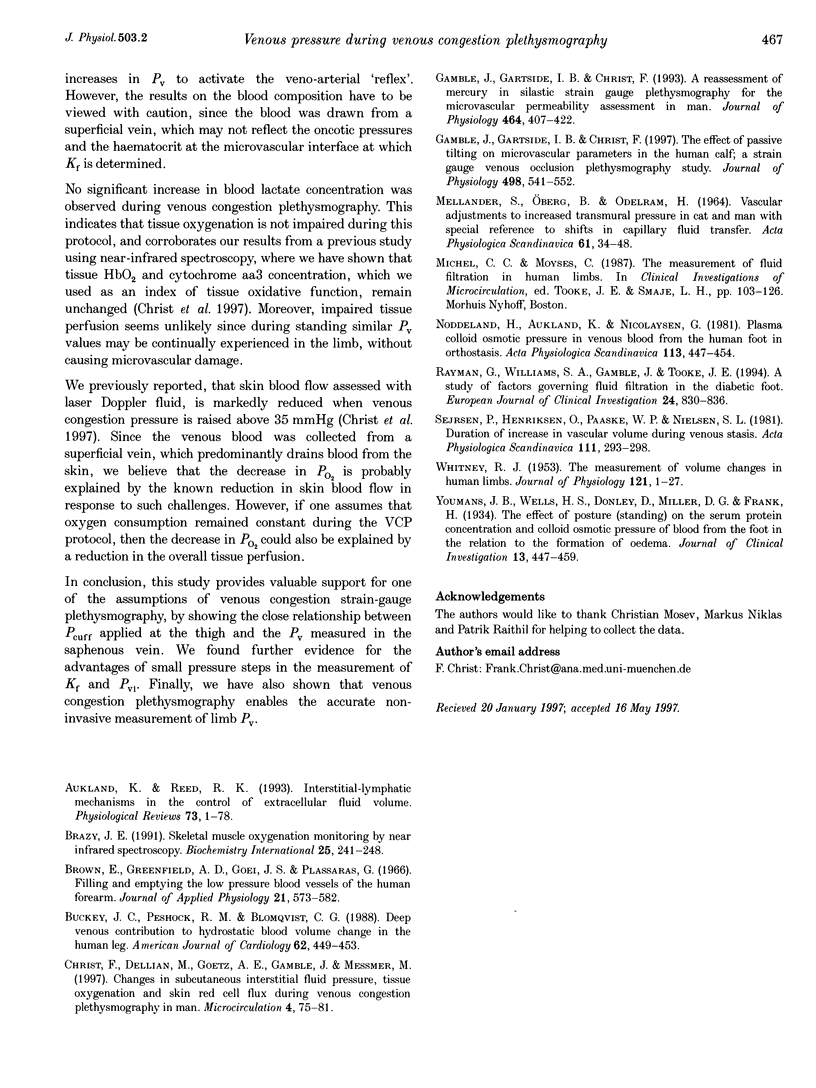Abstract
1. Venous congestion strain-gauge plethysmography enables the non-invasive assessment of arterial blood flow, fluid filtration capacity (Kf), venous pressure (Pv) and isovolumetric venous pressure (Pvi) in man. One of the major assumptions of this technique, that cuff pressure (Pcuff) applied to the limb equals Pv at the level of the strain gauge, was tested in this study. 2. In nine healthy male volunteers (mean age, 29.3 +/- 1.2 years) the saphenous vein was cannulated with an 18-gauge catheter proximal to the medial malleolus. The subjects were supine and Pv was continuously measured during the application of small step (8-10 mmHg) increases in congestion Pcuff (up to 70 mmHg). Pcuff, changes in limb circumference and Pv were recorded by computer for off-line analysis. Since the determination of Kf is influenced by the changes in plasma oncotic pressure, venous blood samples were obtained at the start of the study, when Pcuff was raised to 30 mmHg and again to 65 mmHg and 4 min after deflation of the cuff. 3. The relationship between Pv and Pcuff was linear over the range of 10-70 mmHg (n = 9, 69 measurements, slope 0.91, r = 0.97, P << 0.001). The non-invasively measured calf Pv, based on the intercept of the relationship between the vascular compliance component (Va) and Pcuff, was 8.0 +/- 0.4 mmHg, which was not significantly different from the corrected invasively measured Pv value of 8.8 +/- 0.3 mmHg (P = 0.08). 4. Venous blood lactate and haemoglobin concentrations, as well as colloid osmotic pressure, total protein and albumin concentrations were unchanged throughout the protocol, whereas significant decreases in PO2 and blood glucose concentration were observed when Pcuff reached 65 mmHg. Assuming a constant oxygen consumption, this may suggest a reduction in tissue perfusion. 5. This study demonstrates the close correlation between Pcuff and Pv in the saphenous vein. Since the small congestion Pcuff step protocol does not cause significant increase in plasma oncotic pressure, we conclude that Pv, as well as Kf, can be accurately determined with this venous congestion plethysmography protocol.
Full text
PDF




Selected References
These references are in PubMed. This may not be the complete list of references from this article.
- Aukland K., Reed R. K. Interstitial-lymphatic mechanisms in the control of extracellular fluid volume. Physiol Rev. 1993 Jan;73(1):1–78. doi: 10.1152/physrev.1993.73.1.1. [DOI] [PubMed] [Google Scholar]
- Brown E., Greenfield D. M., Goei J. S., Plassaras G. Filling and emptying of the low-pressure blood vessels of the human forearm. J Appl Physiol. 1966 Mar;21(2):573–582. doi: 10.1152/jappl.1966.21.2.573. [DOI] [PubMed] [Google Scholar]
- Buckey J. C., Peshock R. M., Blomqvist C. G. Deep venous contribution to hydrostatic blood volume change in the human leg. Am J Cardiol. 1988 Sep 1;62(7):449–453. doi: 10.1016/0002-9149(88)90976-9. [DOI] [PubMed] [Google Scholar]
- Christ F., Dellian M., Goetz A. E., Gamble J., Messmer K. Changes in subcutaneous interstitial fluid pressure, tissue oxygenation, and skin red cell flux during venous congestion plethysmography in men. Microcirculation. 1997 Mar;4(1):75–81. doi: 10.3109/10739689709148319. [DOI] [PubMed] [Google Scholar]
- De Blasi R. A., Quaglia E., Ferrari M. Skeletal muscle oxygenation monitoring by near infrared spectroscopy. Biochem Int. 1991 Sep;25(2):241–248. [PubMed] [Google Scholar]
- Gamble J., Christ F., Gartside I. B. The effect of passive tilting on microvascular parameters in the human calf: a strain gauge plethysmography study. J Physiol. 1997 Jan 15;498(Pt 2):541–552. doi: 10.1113/jphysiol.1997.sp021880. [DOI] [PMC free article] [PubMed] [Google Scholar]
- Gamble J., Gartside I. B., Christ F. A reassessment of mercury in silastic strain gauge plethysmography for microvascular permeability assessment in man. J Physiol. 1993 May;464:407–422. doi: 10.1113/jphysiol.1993.sp019642. [DOI] [PMC free article] [PubMed] [Google Scholar]
- MELLANDER S., OBERG B., ODELRAM H. VASCULAR ADJUSTMENTS TO INCREASED TRANSMURAL PRESSURE IN CAT AND MAN WITH SPECIAL REFERENCE TO SHIFTS IN CAPILLARY FLUID TRANSFER. Acta Physiol Scand. 1964 May-Jun;61:34–48. doi: 10.1111/j.1748-1716.1964.tb02940.x. [DOI] [PubMed] [Google Scholar]
- Noddeland H., Aukland K., Nicolaysen G. Plasma colloid osmotic pressure in venous blood from the human foot in orthostasis. Acta Physiol Scand. 1981 Dec;113(4):447–454. doi: 10.1111/j.1748-1716.1981.tb06921.x. [DOI] [PubMed] [Google Scholar]
- Rayman G., Williams S. A., Gamble J., Tooke J. E. A study of factors governing fluid filtration in the diabetic foot. Eur J Clin Invest. 1994 Dec;24(12):830–836. doi: 10.1111/j.1365-2362.1994.tb02027.x. [DOI] [PubMed] [Google Scholar]
- Sejrsen P., Henriksen O., Paaske W. P., Nielsen S. L. Duration of increase in vascular volume during venous stasis. Acta Physiol Scand. 1981 Mar;111(3):293–298. doi: 10.1111/j.1748-1716.1981.tb06739.x. [DOI] [PubMed] [Google Scholar]
- WHITNEY R. J. The measurement of volume changes in human limbs. J Physiol. 1953 Jul;121(1):1–27. doi: 10.1113/jphysiol.1953.sp004926. [DOI] [PMC free article] [PubMed] [Google Scholar]
- Youmans J. B., Wells H. S., Donley D., Miller D. G., Frank H. THE EFFECT OF POSTURE (STANDING) ON THE SERUM PROTEIN CONCENTRATION AND COLLOID OSMOTIC PRESSURE OF BLOOD FROM THE FOOT IN RELATION TO THE FORMATION OF EDEMA. J Clin Invest. 1934 May;13(3):447–459. doi: 10.1172/JCI100597. [DOI] [PMC free article] [PubMed] [Google Scholar]


